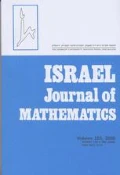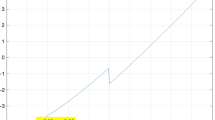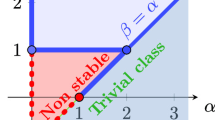Abstract
The well-known Landau’s theorem states that, for any positive integer k, there are finitely many isomorphism classes of finite groups with exactly k (conjugacy) classes. We study variations of this theorem for p-regular classes as well as p-singular classes. We prove several results showing that the structure of a finite group is strongly restricted by the number of p-regular classes or the number of p-singular classes of the group. In particular, if G is a finite group with O p (G) = 1 then |G/F(G)| p' is bounded in terms of the number of p-regular classes of G. However, it is not possible to prove that there are finitely many groups with no nontrivial normal p-subgroup and k p-regular classes without solving some extremely difficult number-theoretic problems (for instance, we would need to show that the number of Fermat primes is finite).
Similar content being viewed by others
References
L. Babai, S. Guest, C. E. Praeger and R. A. Wilson, Proportions of r-regular elements in finite classical groups, Journal of the London Mathematical Society 88 (2013), 202–226.
L. Babai, P. P. Pálfy and J. Saxl, On the number of p-regular elements in finite simple groups, LMS Journal of Computation and Mathematics 12 (2009), 82–119.
R. Brauer, Representations of finite groups, in Lectures on Modern Mathematics, Vol. I, Wiley, New York, 1963, pp. 133–175.
Y. Bugeaud, Z. Cao and M. Mignotte, On simple K4-groups, Journal of Algebra 241 (2001), 658–668.
S. T. Burkett and H. N. Nguyen, Conjugacy classes of small sizes in the linear and unitary groups, Journal of Group Theory 16 (2013), 851–874.
J. H. Conway, R. T. Curtis, S. P. Norton, R. A. Parker and R. A. Wilson, Atlas of Finite Groups, Oxford University Press, Eynsham, 1985.
D. A. Craven, Symmetric group character degrees and hook numbers, Proceedings of the London Mathematical Society 96 (2008), 26–50.
W. Feit, On large Zsigmondy primes, Proceedings of the American Mathematical Society 102 (1988), 29–36.
J. Fulman and R. Guralnick, Bounds on the number and sizes of conjugacy classes in finite Chevalley groups with applications to derangements, Transactions of the American Mathematical Society 364 (2012), 3023–3070.
The GAP Group, GAP—Groups, Algorithms, and Programming, Version 4.6.2, 2013, http://www.gap-system.org.
D. Gorenstein, Finite Simple Groups. An Introduction to their Classification, University Series in Mathematics, Plenum Publishing Corp., New York, 1982.
D. Gorenstein, R. Lyons and R. Solomon, The Classification of the Finite Simple Groups. Number 3. Part I. Chapter A, Mathematical Surveys and Monographs, Vol. 40, American Mathematical Society, Providence, RI, 1998.
M. Herzog, On finite simple groups of order divisible by three primes only, Journal of Algebra 10 (1968), 383–388.
L. Héthelyi and B. Külshammer, Elements of prime power order and their conjugacy classes in finite groups, Journal of the Australian Mathematical Society 78 (2005), 291–295.
I. M. Isaacs, W. M. Kantor and N. Spaltenstein, On the probability that a group element is p-singular, Journal of Algebra 176 (1995), 139–181.
A. Jaikin-Zapirain, On two conditions on characters and conjugacy classes in finite soluble groups, Journal of Group Theory 8 (2005), 267–272.
C. Jansen, K. Lux, R. Parker and R. Wilson, An Atlas of Brauer Characters, London Mathematical Society Monographs, Vol. 11, The Clarendon Press, Oxford University Press, New York, 1995.
T. M. Keller, Finite groups have even more conjugacy classes, Israel Journal of Mathematics 181 (2011), 433–444.
B. Külshammer, Blocks, solvable groups, and Landau’s theorem, Journal für die Reine und Angewandte Mathematik 398 (1989), 180–186.
B. Külshammer, Landau’s theorem for p-blocks of p-solvable groups, Journal für die Reine und Angewandte Mathematik 404 (1990), 189–191.
B. Külshammer and G. R. Robinson, Alperin–McKay implies Brauer’s problem 21, Journal of Algebra 180 (1996), 208–210.
E. Landau, Über die Klassenzahl der binären quadratischen Formen von negativer Discriminante, Mathematische Annalen 56 (1903), 671–676.
M. L. Lewis and J. M. Riedl, Affine semi-linear groups with three irreducible character degrees, Journal of Algebra 246 (2001), 708–720.
O. Manz and T. R. Wolf, Representations of Solvable Groups, London Mathematical Society Lecture Notes Series, Vol. 185, Cambridge University Press, Cambridge, 1993.
A. Maróti and H. N. Nguyen, On the number of conjugacy classes of π-elements in finite groups, Archiv der Mathematik 102 (2014), 101–108.
A. Moretó, Complex group algebras of finite groups: Brauer’s problem 1, Advances in Mathematics 208 (2007), 236–248.
A. Moretó, J. Sangroniz and A. Turull, Sylow subgroups and the number of conjugacy classes of p-elements, Journal of Algebra 275 (2004), 668–674.
H. N. Nguyen, Low-dimensional complex characters of the symplectic and orthogonal groups, Communications in Algebra 38 (2010), 1157–1197.
H. N. Nguyen, Multiplicities of conjugacy class sizes of finite groups, Journal of Algebra 341 (2011), 250–255.
Y. Ninomiya, Finite groups with exactly three p-regular classes, Archiv der Mathematik 57 (1991), 105–108.
Y. Ninomiya, Structure of p-solvable groups with three p-regular classes, Canadian Journal of Mathematics 43 (1991), 559–579.
Y. Ninomiya, Structure of p-solvable groups with three p-regular classes II, Mathematical Journal of Okayama University 35 (1993), 29–34.
Y. Ninomiya and T. Wada, Cartan matrices for blocks of finite p-solvable groups with two simple modules, Journal of Algebra 143 (1991), 315–333.
D. S. Passman, Character theory and group rings, in Character Theory of Finite Groups, Contemporary Mathematics, Vol. 524, American Mathematical Society, Providence, RI, 2010, pp. 139–148.
M. Roitman, On Zsigmondy primes, Proceedings of the American Mathematical Society 125 (1997), 1913–1919.
S. M. Seager, A bound on the rank of primitive solvable permutation groups, Journal of Algebra 116 (1988), 342–352.
W. A. Simpson and J. S. Frame, The character tables for SL(3, q), SU(3, q 2), PSL(3, q), PSU(3, q 2), Canadian Journal of Mathematics 25 (1973), 486–494.
M. Suzuki, On a class of doubly transitive groups, Annals of Mathematics 75 (1962), 105–145.
G. Tiedt, About finite solvable groups with exactly four p-regular conjugacy classes, Hokkaido Mathematical Journal 25 (1996), 249–258.
H. N. Ward, On Ree’s series of simple groups, Transactions of the AmericanMathematical Society 121 (1966), 62–89.
Author information
Authors and Affiliations
Corresponding authors
Additional information
The research of the first author was supported by the Spanish Ministerio de Ciencia y Tecnología, grant MTM2010-15296 and PROMETEO/Generalitat Valenciana.
The second author is partially supported by the NSA Young Investigator Grant #H98230-14-1-0293 and a BCAS Faculty Scholarship Award from the Buchtel College of Arts and Sciences, The University of Akron.
Rights and permissions
About this article
Cite this article
Moretó, A., Nguyen, H.N. Variations of Landau’s theorem for p-regular and p-singular conjugacy classes. Isr. J. Math. 212, 961–987 (2016). https://doi.org/10.1007/s11856-016-1316-7
Received:
Accepted:
Published:
Issue Date:
DOI: https://doi.org/10.1007/s11856-016-1316-7




